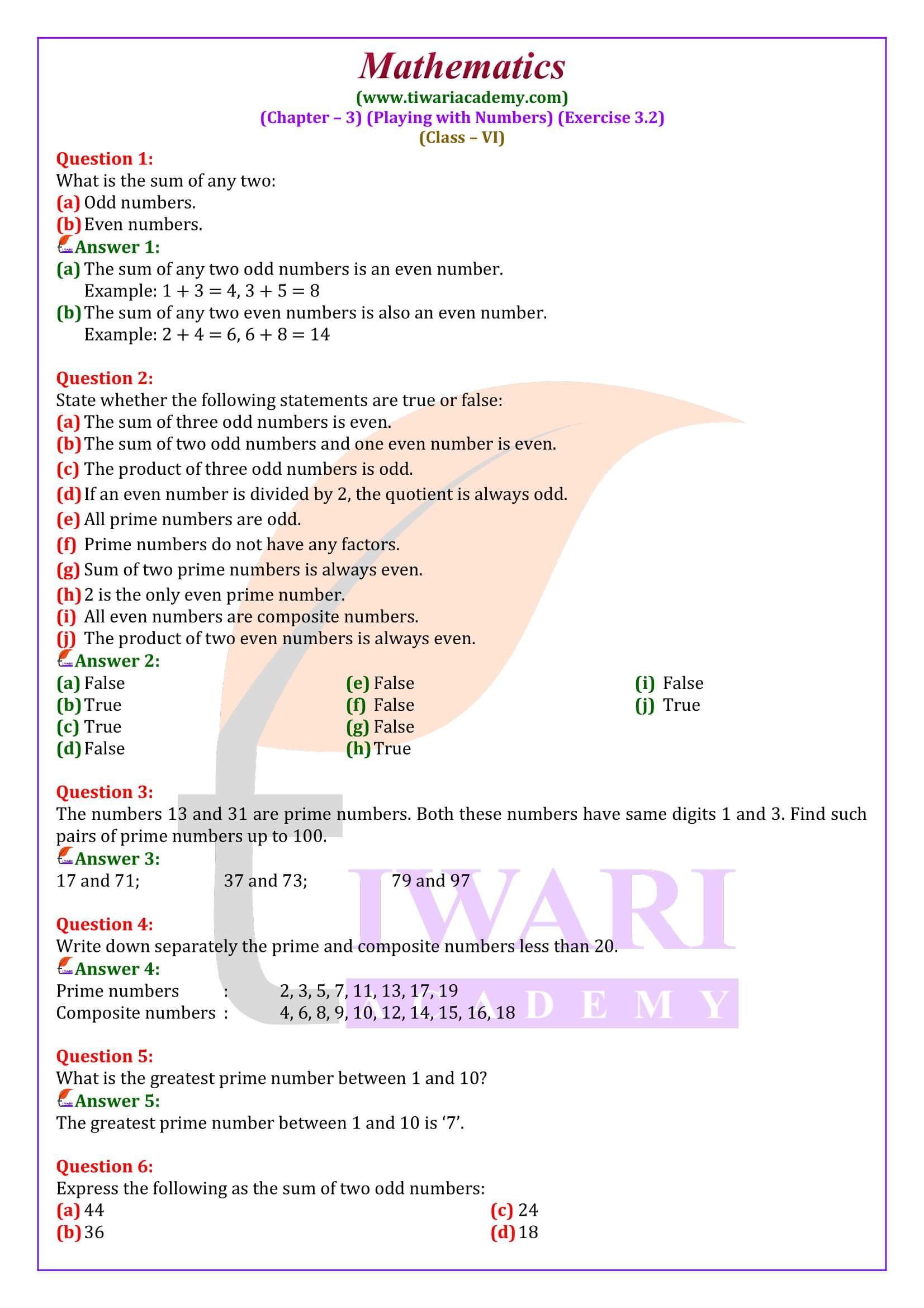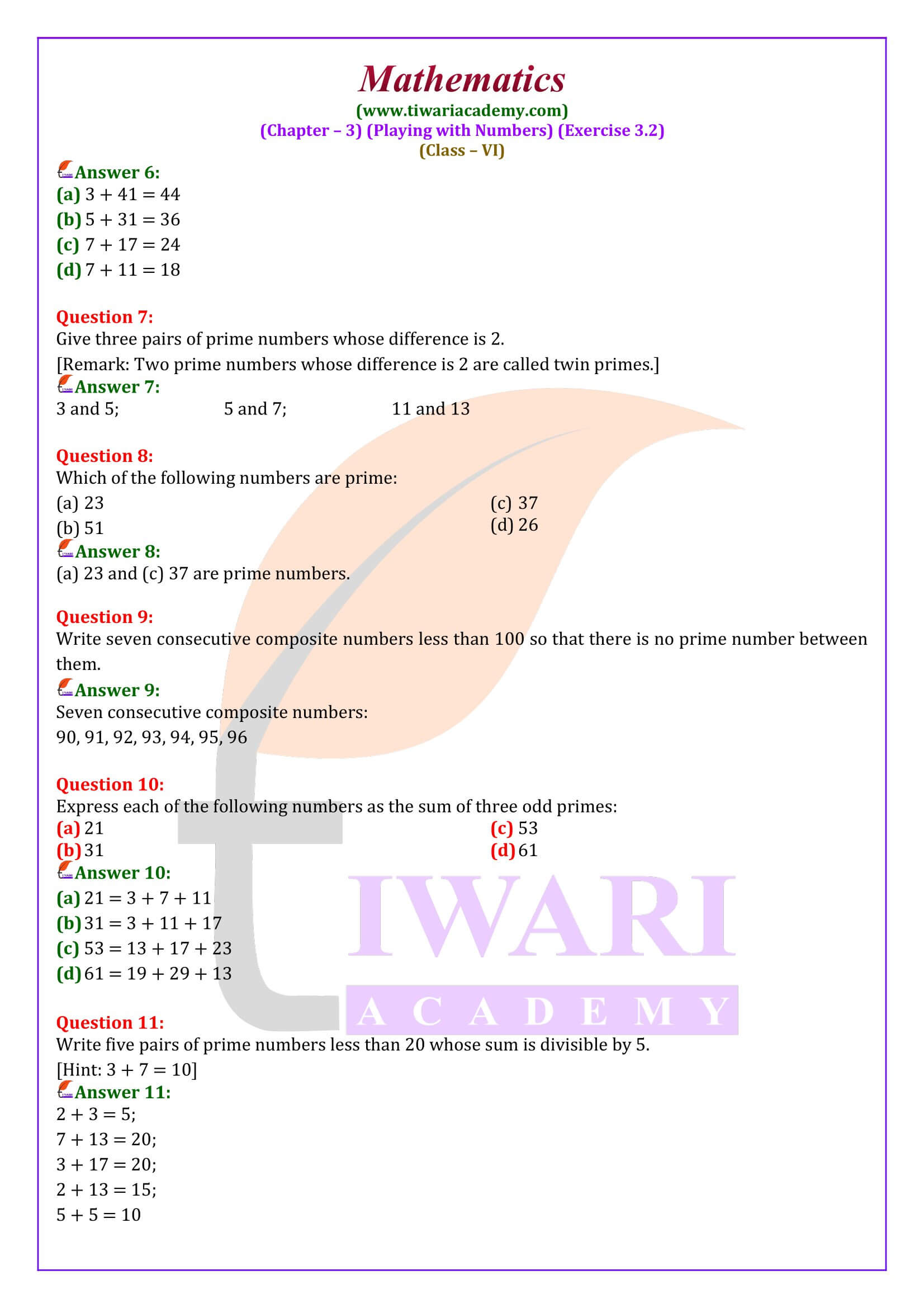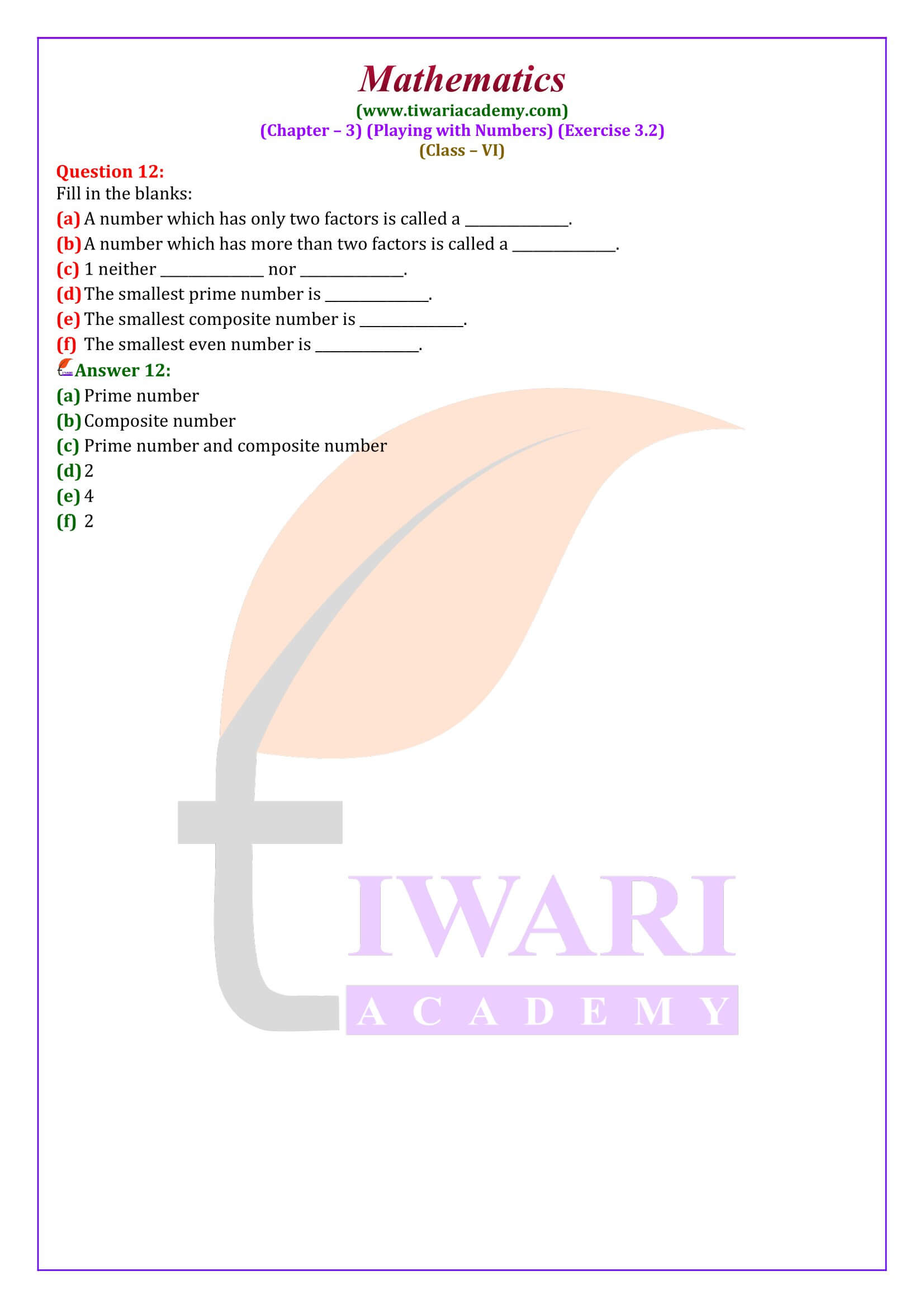NCERT Solutions for Class 6 Maths Chapter 3 Exercise 3.2 in Hindi and English Medium updated and revised for academic session 2025-26. The questions of 6th Maths ex. 3.2 are revised on the basis of new syllabus and latest textbooks for curriculum 2025-26.
6th Maths Exercise 3.2 Solution in Hindi and English Medium
Class 6 Maths Chapter 3 Exercise 3.2 Solution
Class VI Mathematics NCERT Book Ex. 3.2 of chapter 3 Playing with Numbers free to use online or download in PDF format based on CBSE and State board. All the solution of Grade 6 NCERT is updated for academic session 2025-26 free to use online or download to use offline. All the questions are solved in simplest way so that students can understand easily.
| Class: 6 | Mathematics |
| Chapter: 3 | Exercise: 3.2 |
| Topic Name: | Playing with Numbers |
| Medium: | Hindi and English Medium |
| Content Type: | Online Text and Videos |
| Academic Session: | 2025-26 |
General Properties of Divisibility
Property 1:
If a number is divisible by another number, it must be divisible by each of the factors of that number.
Example: We know that 48 is divisible by 12. All the factors of 12 are 1, 2, 3, 4, 6 and 12. Clearly, 48 is divisible by each one of 1, 2, 3, 4, 6 and 12.
Property 2:
If a number is divisible by each of the two co-prime numbers, it must be divisible by their product.
Example: We know that 672 is divisible by each of the numbers 2 and 3. Also, 2 and 3 are co-primes. Therefore, 672 must be divisible by 6.
Property 3:
If a number is a factor of each of the two given numbers, then it must be a factor of their sum.
Example: We know that 8 is a factor of 48 as well as that of 64. So, 8 must be a factor of (48 + 64) = 112. Clearly, 8 divides 112 exactly.
Property 4:
If a number is a factor of each of the two given numbers, then it must be a factor of their difference.
Example: We know that 3 is a factor of each one of the numbers 15 and 27. So, 3 must be a factor of (27 – 15) = 12. Clearly, 12 = 4 × 3, i.e., 3 is a factor of 12.
Important Questions for Class 6 Maths Exercise 3.2
Examine whether the following are prime numbers or not? (i) 127 (ii) 133
(i) Test the divisibility of 127 by each one of the prime numbers 2, 3, 5, 7, 11 and 13. We find that 127 is divisible by none of them. So, 127 is a prime number.
(ii) Test the divisibility of 133 by each one of the prime numbers 2, 3, 5, 7, 11 and 13. We find that 133 is divisible by 7. So, 133 is not prime number.
Which of the following is a prime number? (i) 331 (ii) 323
(i) Test the divisibility of 331 by each one of the prime numbers 2, 3, 5, 7, 11,13, 17 and 19. We find that 331 is not divisible by any one of these numbers. So, 331 is a prime number.
(ii) Test the divisibility of 323 by each one of the prime numbers 2, 3, 5, 7, 11,13, 17 and 19. Clearly, 323 is divisible by 17. So, it is not a prime number.
Test the divisibility of the following numbers by 2: (i) 854, (ii) 2265, (iii) 4735
(i) 854 is even number and divisible by 2. As we apply last two-digit method here last two digits are 54 And 54 is divisible by 2.
(ii) 2265 is an odd number which is not divisible completely by 2. As we apply last two-digit method here last two digits are 65. 65 is not divisible by 2.
(iii) 4735 is also an odd number which is not divisible completely by 2. Here last two digits are 35 which is not divisible by 2.
Test the divisibility of the following numbers by 4: (i) 486528 (ii) 3020525
(i) Here we apply same last two-digit rule. Here 28 are last two digits which is divisible by 4. Hence 486528 is divisible by 4.
(ii) here last two digits are 25 which not divisible by 4.so number 3020525 is not divisible by 4.
To Find Prime Numbers Between 100 And 200
Rule: Examine whether the given number is divisible by any prime number less than 15, i.e., 2, 3, 5, 7, 11 and 13. If it is divisible, then it is not prime, otherwise, it is prime.
Class 6 Maths Exercise 3.2 Extra Questions with Answres
how can we find prime numbers between 100 and 200?
To Find Prime Numbers Between 100 And 200
Examine whether the given number is divisible by any prime number less than 15, i.e., 2, 3, 5, 7, 11 and 13. If it is divisible, then it is not prime, otherwise, it is prime.
Example:
Test the divisibility of 127 by each one of the prime numbers 2, 3, 5, 7, 11 and 13.
We find that 127 is divisible by none of them. So, 127 is a prime number.
In each of the following numbers, replace (*) by the smallest number to make it divisible by 3 (i) 6*1045, (ii) 53*46
(i) 6*1045, here 6 + * + 1 + 0 + 4 + 5 = 16 + *, after 16 the number divisible by 3 is 18. Hence * should be replaced by 2. Number is 621045.
(ii) 53*46, here 5 + 3 + * + 4 + 6 = 18 + *, we know 18 is divisible by 3 so we replace * by 0 and number will be 53046.
In 9*8071, replace (*) by the smallest number to make it divisible by 11.
We write Number 9*8071 as 9 + * + 8 + 0 + 7 + 1 = 25 + *, we know that after 25 it is 33 which is divisible by 11. Hence 25 + 8 = 33. In number 9*8071, * should be replaced by 8.
Which of the following are prime numbers? 277, 143, 167, 263, 179, 357, 217, 291, 397, 203.
By applying divisible method, we divide numbers by 2, 3, 5, 7, 11 either we get whole number or not.
277, 167, 263, 179, 397 these are prime numbers.
To Find Prime Numbers Between 100 And 400
Rule: Examine whether the given number is divisible by any prime number less than 20, i.e., 2, 3, 5, 7, 11,13, 17 and 19. If it is divisible, then it is not prime, otherwise, it is prime.
Can short answer-type questions come from exercise 3.2 of 6th Maths?
Yes, short answer type questions like fill in the blanks, MCQ, true or false, yes or no, answer in one word, etc can come from exercise 3.2 of class 6th Maths.
How much time is required to complete exercise 3.2 of class 6th Maths?
Students require at most 3 days to complete exercise 3.2 of class 6th Maths if they give 1 hour per day to this exercise. This time depends on teachers and students also because no teacher and students can have the same working speed.
Which questions of exercise 3.2 of class 6th Maths are the expected for the exams?
Exercise 3.2 of grade 6th Maths is important from the exam point of view. Every year questions come from this exercise in the exams. There are 12 questions and one example (example 4) in exercise 3.2. All the questions of this exercise are good, logical, and can come in the exams. The most important questions of this exercise that teachers can give in the exams are questions 2, 8, 10, and 12.
Is exercise 3.2 (chapter 3) of class 6th Maths easy or tough to solve?
Exercise 3.2 (chapter 3) of class 6th Maths is not easy and not tough. It lies in the mid of easy and tough because some questions of this exercise are easy, and some are complicated. However, the difficulty level of any question varies from child to child. So, exercise 3.2 (chapter 3) of class 6th Maths is easy, or tough depends on children also. Some children find it complex, some find it simple, and some find it in the middle of easy and hard.






